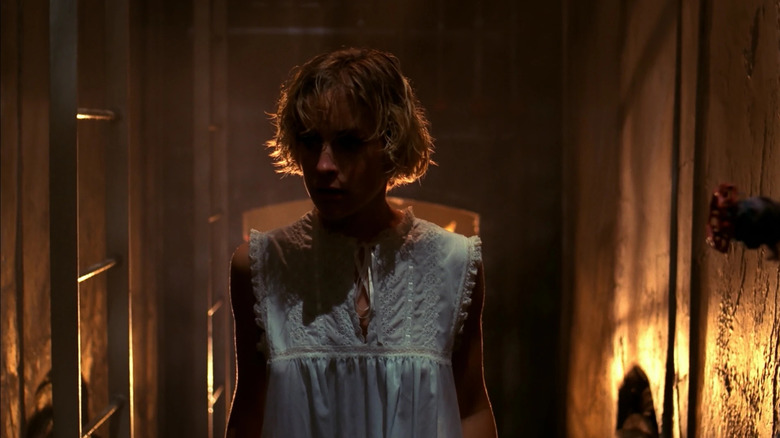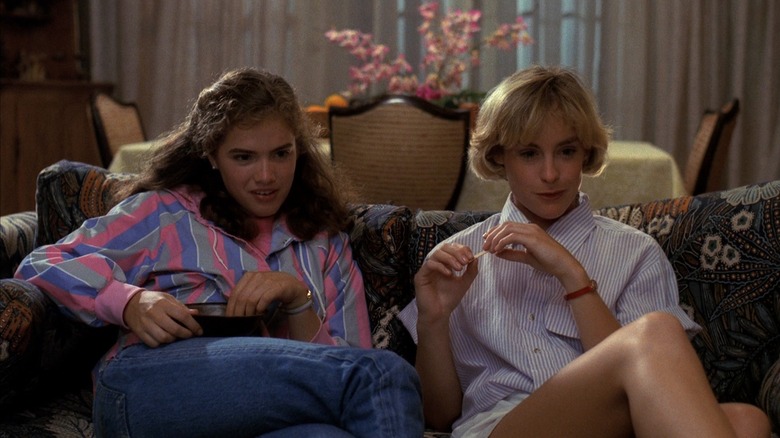A Deleted Moment In A Nightmare On Elm Street Could Have Gotten The Entire Movie Scrapped
Early in Wes Craven's 1984 horror film "A Nightmare on Elm Street," the character of Tina (Amanda Wyss) has a violent dream about the demonic, blade-handed Freddy Krueger (Robert Englund). Freddy has been stalking the dreams of all the neighborhood teens, and the nightmares are so vivid that they fear for their lives. Tina dreams that Freddy is chasing her down an alley, that he cuts off his own fingers and feels nothing, and that he can teleport into her bedroom.
In one of the film's more notorious scenes, Tina is attacked and sliced up by Freddy who, defying gravity, drags her onto the wall of her bedroom and up onto the ceiling as she bleeds to death. Once Tina has perished, her body falls from the ceiling onto her bed, landing in a pool of blood, splattering the walls and the face of her poor helpless boyfriend Rod (Nick Corri), who witnessed the entire thing.
The scene was both terrifying and unique for the genre. Indeed, it became so notorious, that the sequence was repeated by Craven in his 1994 meta-narrative follow-up "Wes Craven's New Nightmare" on actress Tracy Middendorf, playing a babysitter named Julie. It's amazing to ponder that Craven changed the direction of cinematic horror three decades in a row. In the 1970s, he made "The Last House on the Left," in the '80s it was "Nightmare," and in the '90s it was "Scream." But I digress.
The death-on-the-ceiling scene, however, was almost too bloody for the studio. In a 2014 interview with Hero Magazine, Craven recalls that the blood-splashing part of Tina's death scene was just a hair too gory. Craven recalls having to cut a fraction of a second of splatter to appease them.
12 frames of blood
Traditionally, film is run at 24 frames per second, so the censorship Craven is about to refer to is only a half of a second long. But that half-second was enough to make New Line Cinema skittish. Craven recalls making the cut and feeling that even a half second made the scene feel different and threw off the pace. He hated it. Craven recalled:
"One of the most painful cuts is in 'Nightmare on Elm Street' was when Tina is dragged up across the ceiling of her bedroom and then falls onto the bed and you know, we had the bed three inches deep in blood, and when the stunt woman hit it there was this startling and really shocking spray of blood all over everything. It was probably twelve frames, something like that, but those twelve frames had to go or we they would have axed the movie. Every time I see that film, I see that abrupt cut there."
The scene is still scary, but a savvy viewer will be able to see where the cut was made. Absurd to think that the scene is of a teenage girl being sliced to ribbons, but the studio only had an issue with the blood splatter after she had already died.
This type of censorship is common in feature films. David Lynch fans may know that the only difference between the R-rated cut of "Wild at Heart" and the unrated cut is a split second wherein Willem Dafoe's head is splattered open by a shotgun. The R-rated version of the scene merely contains an opaque cloud of smoke, covering the brief moment of extreme gore. At the very least, Craven wasn't asked to visually obscure the blood. A straightforward cut likely functions better for the scene.
Craven's wrestling with censorship
Craven may have regretted the cut, but it's likely he was able to take it in stride, given the history of his early movies being censored around the world. His 1972 film "The Last House on the Left" and his 1977 film "The Hills Have Eyes" were two of the notorious "Video Nasties" targeted by the British censorship boards in the mid-1980s. It wouldn't be until an appeal in 2004 that "Last House" would finally be granted an "R" rating by the MPA. On one of the film's DVD releases, Craven noted — at the time — that his movie hadn't yet ever been given a theatrical run in England.
No distributor in Australia would exhibit "Last House," and "Hills" was banned for "indecent violence." It seems that several early cuts of the movie didn't pass muster, and it wasn't until 1979 that "Hills" received an "R" rating. Since then, unrated cuts have made their way to home video. A TV version of "Hills" also exists, although that version is missing a full 30 minutes of footage. Note that the original cut of "Hill" was only 89 minutes. Clever archivists and film historians have meticulously laid out what changes have been made as Craven's films were carefully sliced up throughout their histories.
Even after "A Nightmare on Elm Street," Craven continued to have censorship issues. "The Hills Have Eyes Part 2" in 1985 required that a single shot be cut in order to achieve a coveted R-rating. There was a one-second moment wherein a character was shown dead, their throat having been cut. That shot was cut from the initial run of "Hills 2."
In 2023, most of Craven's films can be seen in their most violent versions. A relief for horror fans everywhere.


